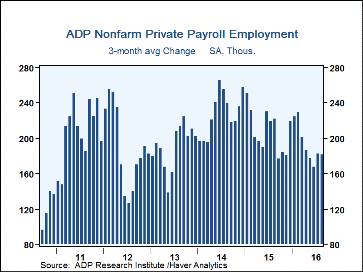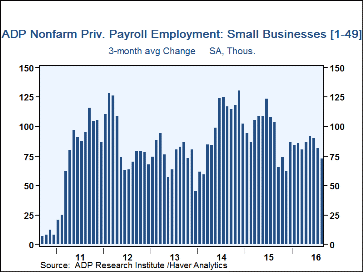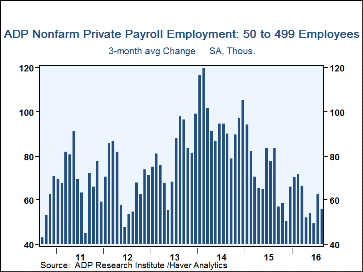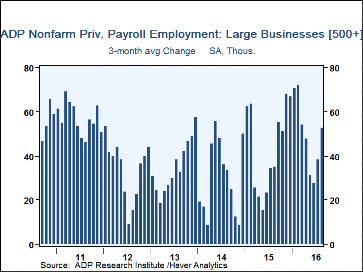 Global| Aug 31 2016
Global| Aug 31 2016U.S. ADP Private Payrolls Stay on Moderate Growth Path
by:Tom Moeller
|in:Economy in Brief
Summary
The ADP/Moody's National Employment Report showed a 177,00 rise (1.9% y/y) in nonfarm private sector payrolls during August following a 194,000 July gain, revised from 179,000. So far this year, payrolls rose an average 184,000 per [...]
The ADP/Moody's National Employment Report showed a 177,00 rise (1.9% y/y) in nonfarm private sector payrolls during August following a 194,000 July gain, revised from 179,000. So far this year, payrolls rose an average 184,000 per month, down from 207,000 averaged during 2015, and 234,000 averaged in 2014. The latest increase compared to expectations for a 175,000 rise in the Action Economics Forecast Survey. During the last ten years, there has been a 96% correlation between the change in the ADP figure and the change in nonfarm private sector payrolls as measured by the Bureau of Labor Statistics.
The ADP Research Institute survey is based on ADP's business payroll transaction system covering 411,000 companies and nearly 24 million employees. The data are processed by Moody's Analytics Inc., then calibrated and aligned with the BLS establishment survey data. The ADP data cover private sector employment only.
Small-sized business payrolls increased 63,000 (1.9% y/y) after a 68,000 gain. These increases were down from the high of 124,000 averaged in Q2'14. Hiring by medium-sized businesses rose 44,000 (1.6% y/y) compared to a 71,000 July increase, less than the 105,000 averaged in Q4'14. Large-sized businesses posted a 70,000 rise in jobs (2.5% y/y), the strongest since February.
Service-producing payrolls increased 183,000 (2.3% y/y) after a 199,000 rise. Professional & business payrolls rose 53,000 (3.0% y/y). Trade, transportation & utilities jobs improved 26,000 (1.4% y/y). Financial activity payrolls increased 26,000 (1.9% y/y).
Goods-producing jobs fell 6,000 (+0.1% y/y), the sixth decline in the last seven months. The construction industry shed 2,000 jobs (+2.4% y/y), the third straight monthly decline. Peak monthly hiring growth of 33,000 construction workers occurred in Q4'14. Hiring in the factory sector remained unchanged (-0.3% y/y) after a 5,000 rise. Job cutbacks in Q2 and Q1 averaged 9,000 and 3,000 per month, respectively.
The ADP National Employment Report data are maintained in Haver's USECON database; historical figures date back to April 2001 for the total and industry breakdown, and back to January 2005 for the business size breakout. The expectation figure is available in Haver's AS1REPNA database.
| ADP/Moody's National Employment Report | Aug | Jul | Jun | Aug Y/Y | 2015 | 2014 | 2013 |
|---|---|---|---|---|---|---|---|
| Nonfarm Private Payroll Employment (m/m chg, 000s) | 177 | 194 | 171 | 1.9% | 2.3% | 2.2% | 1.9% |
| Small Payroll (1-49) | 63 | 68 | 87 | 1.9 | 2.6 | 2.1 | 1.9 |
| Medium Payroll (50-499) | 44 | 71 | 53 | 1.6 | 2.3 | 2.8 | 2.2 |
| Large Payroll (>500) | 70 | 56 | 31 | 2.5 | 1.7 | 1.6 | 1.5 |
| Goods-Producing | -6 | -5 | -28 | 0.1 | 1.8 | 2.4 | 1.8 |
| Construction | -2 | -5 | -3 | 2.4 | 4.5 | 4.7 | 3.7 |
| Manufacturing | 0 | 5 | -16 | -0.3 | 1.1 | 1.3 | 0.8 |
| Service-Producing | 183 | 199 | 199 | 2.3 | 2.4 | 2.2 | 1.9 |
Tom Moeller
AuthorMore in Author Profile »Prior to joining Haver Analytics in 2000, Mr. Moeller worked as the Economist at Chancellor Capital Management from 1985 to 1999. There, he developed comprehensive economic forecasts and interpreted economic data for equity and fixed income portfolio managers. Also at Chancellor, Mr. Moeller worked as an equity analyst and was responsible for researching and rating companies in the economically sensitive automobile and housing industries for investment in Chancellor’s equity portfolio. Prior to joining Chancellor, Mr. Moeller was an Economist at Citibank from 1979 to 1984. He also analyzed pricing behavior in the metals industry for the Council on Wage and Price Stability in Washington, D.C. In 1999, Mr. Moeller received the award for most accurate forecast from the Forecasters' Club of New York. From 1990 to 1992 he was President of the New York Association for Business Economists. Mr. Moeller earned an M.B.A. in Finance from Fordham University, where he graduated in 1987. He holds a Bachelor of Arts in Economics from George Washington University.










